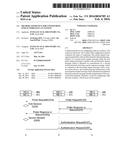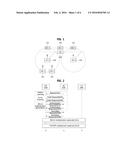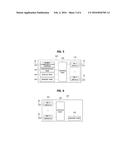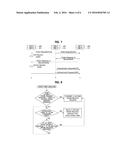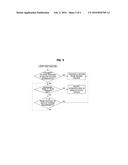Patent application title: METHOD AND DEVICE FOR CONFIGURING LINK IN WIRELESS LAN SYSTEM
Inventors:
Ju Hyung Son (Uiwang-Si, KR)
Ju Hyung Son (Uiwang-Si, KR)
Jin Sam Kwak (Uiwang-Si, KR)
Jin Sam Kwak (Uiwang-Si, KR)
Assignees:
INTELLECTUAL DISCOVERY CO., LTD.
IPC8 Class: AH04L12801FI
USPC Class:
370230
Class name: Multiplex communications data flow congestion prevention or control control of data admission to the network
Publication date: 2016-02-04
Patent application number: 20160036705
Abstract:
A method and device for configuring a link in a wireless LAN system are
disclosed. The wireless link configuration method comprises the steps of:
acquiring a first probe request message transmitted by a first mobile
terminal; delaying the transmission of a second probe request message
when the first probe request message is similar to the second probe
request message which is prepared for transmission by a second mobile
terminal; receiving a probe response message, which is a response to the
first probe request message, from a wireless access device; and
withdrawing the transmission of the second probe request message when
information included in the probe response message satisfies requirements
of the second mobile terminal. Therefore, a time for configuring a link
between wireless LAN devices can be reduced.Claims:
1. A method of configuring a wireless link, performed in a second mobile
station, the method comprising: obtaining a first probe request message
transmitted from a first mobile station; when the first probe request
message is similar to a second probe request message which the second
mobile station prepares to transmit, delaying transmission of the second
probe request message; receiving a probe response message from a wireless
access station in response to the first probe request message; and when
information included in the probe response message satisfies requirements
of the second mobile station, cancelling the transmission of the second
probe request message.
2. The method of claim 1, wherein, in the delay transmission of the second probe request message, when service set identifiers (SSID) of the first probe request message and the second probe request message coincide with each other, the second probe request message is delayed for at least a maximum channel time (MaxChannelTime).
3. The method of claim 1, further comprising transmitting the second probe request message, when capability information included in the probe response message does not satisfy the requirements of the second mobile station.
4. The method of claim 1, further comprising requesting authentication to the wireless access station by using wireless access information obtained from the probe response message.
5. A second mobile station comprising: a control part controlling operations of the second mobile station; and at least one network interface card for transmitting and receiving data based on commands of the control part, wherein the control part obtains a first probe request message transmitted from a first mobile station, delays transmission of the second probe request message when the first probe request message is similar to a second probe request message which the second mobile station prepares to transmit, receives a probe response message from a wireless access station in response to the first probe request message, and cancels the transmission of the second probe request message when information included in the probe response message satisfies requirements of the second mobile station.
6. The station of claim 5, wherein, when service set identifiers (SSID) of the first probe request message and the second probe request message coincide with each other, the control part delays the second probe request message for at least a maximum channel time (MaxChannelTime).
7. The station of claim 5, wherein the control part transmits the second probe request message, when a capability element included in the probe response message does not satisfy the requirements of the second mobile station.
8. The station of claim 5, wherein the control part requests authentication to the wireless access station by using wireless access information obtained from the probe response message.
Description:
TECHNICAL FIELD
[0001] A variety of example embodiments according to the present invention generally relate to configuration of a wireless link, and more specifically to methods and devices for rapidly configuring an initial link in a wireless local area networking (WLAN) system.
BACKGROUND ART
[0002] Currently, according to wide distribution of mobile stations, a wireless local area networking (WLAN) technology which can provide faster wireless internet services to the mobile stations is becoming remarkable. The WLAN technology is a technology which can make mobile stations such as smart phones, smart pads, laptop computers, portable multimedia players, embedded devices, etc. able to wirelessly access an internet in home, company, or specific service provision areas, based on wireless communication technologies.
DISCLOSURE
Technical Problem
[0003] The present invention is to provide methods for configuring a wireless link between WLAN devices in a congested environment having a large number of wireless devices.
[0004] Also, the present invention is to provide apparatuses for configuring a wireless link between WLAN devices in a congested environment having a large number of wireless devices.
Technical Solution
[0005] In order to achieve the purposes of the present invention, according to an example embodiment according to the present invention, a method may be provided for configuring a wireless link and performed in a second mobile station. The method may comprise obtaining a first probe request message transmitted from a first mobile station; delaying transmission of the second probe request message when the first probe request message is similar to a second probe request message which the second mobile station prepares to transmit; receiving a probe response message from a wireless access station in response to the first probe request message; and cancelling the transmission of the second probe request message when information included in the probe response message satisfies requirements of the second mobile station.
[0006] Here, in the delay transmission of the second probe request message, when service set identifiers (SSID) of the first probe request message and the second probe request message coincide with each other, the second probe request message may be delayed for at least a maximum channel time (MaxChannelTime).
[0007] Here, the method may further comprise transmitting the second probe request message, when capability information included in the probe response message does not satisfy the requirements of the second mobile station.
[0008] Here, the method may further comprise requesting authentication to the wireless access station by using wireless access information obtained from the probe response message.
[0009] In order to achieve the purposes of the present invention, according to another example embodiment according to the present invention, the second mobile station may comprise a control part controlling operations of the second mobile station, and at least one network interface card for transmitting and receiving data based on commands of the control part. Also, the control part may obtain a first probe request message transmitted from a first mobile station, delay transmission of the second probe request message when the first probe request message is similar to a second probe request message which the second mobile station prepares to transmit, receive a probe response message from a wireless access station in response to the first probe request message, and cancel the transmission of the second probe request message when information included in the probe response message satisfies requirements of the second mobile station.
[0010] Here, when service set identifiers (SSID) of the first probe request message and the second probe request message coincide with each other, the control part may delay the second probe request message for at least a maximum channel time (MaxChannelTime).
[0011] Here, the control part may transmit the second probe request message, when capability information included in the probe response message does not satisfy the requirements of the second mobile station.
[0012] Here, the control part may request authentication to the wireless access station by using wireless access information obtained from the probe response message.
Advantageous Effects
[0013] According to example embodiments of the present invention, a time needed for configuring wireless links between WLAN devices can be reduced when a large number of WLAN devices request wireless link configurations in a congested area. Especially, according to example embodiments of the present invention, when multiple mobile stations transmit a plurality of probe request messages at the same time, the time needed for configuring wireless links can be reduced by minimizing collisions between probe response messages corresponding to the probe request messages.
DESCRIPTION OF DRAWINGS
[0014] FIG. 1 conceptually illustrates an example configuration of a WLAN system to which embodiments of the present invention can be applied.
[0015] FIG. 2 conceptually illustrate a step in which MS configures a link with AP according to an example embodiment of the present invention.
[0016] FIG. 3 illustrates a passive scanning step of MS related to an example embodiment of the present invention.
[0017] FIG. 4 illustrates an active scanning step of MS related to an example embodiment of the present invention.
[0018] FIG. 5 is a block diagram which conceptually illustrates a mobile station (MS) 100 related to an example embodiment of the present invention.
[0019] FIG. 6 is a block diagram which conceptually illustrates an access point 200 related to an example embodiment of the present invention.
[0020] FIG. 7 is a flow chart illustrating a WLAN access procedure according to an example embodiment of the present invention for a case in which a plurality of mobile stations try to access an AP simultaneously.
[0021] FIG. 8 illustrates a detailed logic of a first analysis in the example embodiment of FIG. 7.
[0022] FIG. 9 illustrates a detailed logic of a second analysis in the example embodiment of FIG. 7.
[0023] FIG. 10 illustrates a packet structure of a beacon message transmitted by AP according to the present invention.
[0024] FIG. 11 illustrates a packet structure of a probe request message transmitted by MS according to the present invention.
[0025] FIG. 12 illustrates a packet structure of a probe response message transmitted by AP according to the present invention.
MODE FOR INVENTION
[0026] Since embodiments described in the present specification are intended to clearly describe the spirit of the present invention to those skilled in the art to which the present invention pertains, the present invention is not limited to those embodiments described in the present specification, and it should be understood that the scope of the present invention includes changes or modifications without departing from the spirit of the invention.
[0027] The terms and attached drawings used in the present specification are intended to easily describe the present invention and shapes shown in the drawings are exaggerated to help the understanding of the present invention if necessary, and thus the present invention is not limited by the terms used in the present specification and the attached drawings.
[0028] In the present specification, detailed descriptions of known configurations or functions related to the present invention which have been deemed to make the gist of the present invention unnecessarily obscure will be omitted below.
[0029] Hereinafter, a method and a device for fast accesses between WLAN devices using a plurality of communication channels according to embodiments of the present invention will be described.
[0030] Among standards of WLAN technologies, standardization on Medium Access Control (MAC) and Physical (PHY) layers are going on in an Institute of Electrical and Electronics Engineers (IEEE) 802.11 working group.
[0031] FIG. 1 conceptually illustrates an example configuration of a WLAN system to which embodiments of the present invention can be applied.
[0032] Referring to FIG. 1, the WLAN system may include one or more basic service sets (BSS) 211 and 221. The BSS 211 or 221 is a set of stations which can communicate with each other, and managed by an access point (AP) 210 or 220. A mobile station (MS) 110 or 120 may perform a role of providing wireless internet services to a user by accessing the AP 210 or 220 according to IEEE 802.11 WLAN standards. The BSS 211 or 221 may be classified into an infrastructure BSS and an independent BSS, and the infrastructure BSS is illustrated in FIG. 1. The BSS-1 211 is managed and operated by the AP-1 210, and one or more MSs including MS-1 110 and MS-2 120 may receive WLAN services through the AP-1 210. Also, the AP-1 210 is connected to the AP-2 220 through a distribution system (DS) 300. The BSSs 211 and 221 connected through the DS 300 may form an extended service set (ESS) 410. Since the detail of configurations of WLAN systems is described in the standard specifications such as IEEE 802.11-2012 (Mar. 29, 202), explanation on the detail will be omitted herein. The contents of the standard specifications may be combined to the present description for reference.
[0033] FIG. 2 conceptually illustrate a step in which MS configures a link with AP according to an example embodiment of the present invention.
[0034] Referring to FIG. 2, a procedure for MS 100 to access AP 200 may comprise three steps--scanning, authentication, and association. The scanning step is a step in which the MS 100 obtains access information of a BSS operated by the AP 200. For the scanning, there are a passive scanning technique S101 that obtains information by using beacon messages which are periodically transmitted by the AP, and an active scanning technique in which the MS transmits a probe request to the AP (S103), receives a probe response from the AP (S105), and obtains access information from the probe response.
[0035] The MS 100 which successfully receives the wireless access information in the scanning step may perform the authentication step by transmitting an authentication request (S107a) and receiving an authentication response (S107b). After successful completion of the authentication step in the IEEE 802.11 layer, the association step (S109a and S109b) may be performed. In addition, authentication based on 802.1X (S111) and a step of obtaining IP address through DHCP (S113) may be performed.
[0036] FIG. 3 illustrates a passive scanning step of MS related to an example embodiment of the present invention. Referring to FIG. 3, the MS-1 110 according to the present invention may obtain wireless access information or respective APs by receiving beacon message which are periodically transmitted by AP-1 210 and AP-2 220 located adjacently.
[0037] FIG. 4 illustrates an active scanning step of MS related to an example embodiment of the present invention.
[0038] Referring to FIG. 4, the MS-1 110 according to the present invention may transmits a probe request message to obtain information of APs located adjacently, and obtain wireless access information of respective APs by receiving the corresponding probe response messages from AP-1 210 and AP-2 220.
[0039] FIG. 5 is a block diagram which conceptually illustrates a mobile station (MS) 100 related to an example embodiment of the present invention.
[0040] Referring to FIG. 5, the MS 100 according to the present invention may comprise at least one network interface cards (NIC) 111 to 119 performing a WLAN access through an AP. The network interface cards 111 to 119, modules for performing WLAN access, may be embedded within the MS or installed in outside of the MS. The network interface cards 111 to 119 may perform wireless communications with the AP according to respective supported WLAN specifications. Also, among the network interface cards 111 to 119, only one NIC may operate at a time or a plurality of NICs may simultaneously operate according to performance of the MS 100 or system requirements. In the MS 100 of FIG. 5, the multiple NICs 111 to 119 are illustrated as separated, and MAC and PHY layers of each NIC may operate independently from each other. These NICs 111 to 119 may be implemented as a functional entity which can be separated physically or as a single integrated physical entity.
[0041] A mobile communication module 120 may make the MS 100 transmit and receive wireless signals to/from an external device in a mobile communication network.
[0042] A user interface part 130 may make commands for controlling the MS 100 be input by a user. A display part 140 may display results from operations of the MS 100, status of the MS 100, and information provided by the AP.
[0043] A memory part 150 may store access program codes for controlling access to the AP, and various data for the program codes.
[0044] A control part 160 may perform a role of controlling each of the NICs 111 to 119 to make the MS 100 try to access the AP through an appropriate frequency band by using access information provided by the AP and user/system requirements.
[0045] FIG. 6 is a block diagram which conceptually illustrates an access point 200 related to an example embodiment of the present invention.
[0046] Referring to FIG. 6, the AP 200 according to the present invention may comprise at least one network interface cards (NIC) 211 to 219 for operating BSS in one or more frequency bands. The network interface cards 211 to 219, modules for performing WLAN access, may be embedded within the AP 200 or installed in outside of the AP 200. The NICs 211 to 219 may perform wireless communications with the MS according to respective supported WLAN specifications. Also, among the network interface cards 211 to 219, only one NIC may operate at a time or a plurality of NICs may simultaneously operate according to performance of the AP 200 or system requirements. In the AP 200 of FIG. 6, a plurality of NICs 211 to 219 are illustrated as separated, and MAC and PHY layers of each NIC may operate independently from each other. These NICs 211 to 219 may be implemented as a functional entity which can be separated physically or as a single integrated physical entity.
[0047] A memory part 250 may store access program codes for controlling access from mobile stations, and various data for the program codes. A control part 260 may perform a role of controlling each of the NICs 211 to 219 to make the AP 200 process access from MS through an appropriate frequency band by using access information for multiple frequency bands and user/system requirements.
[0048] FIG. 7 is a flow chart illustrating a WLAN access procedure according to an example embodiment of the present invention for a case in which a plurality of MSs try to access an AP simultaneously, FIG. 8 illustrates a detailed logic of a first analysis in the example embodiment of FIG. 7, and FIG. 9 illustrates a detailed logic of a second analysis in the example embodiment of FIG. 7.
[0049] Referring to FIGS. 7 to 9, a first mobile station 100 may transmit a first probe request message (S103, S103a). Also, a second mobile station 400 may obtain (i.e., overhear) the first probe request message transmitted from the first mobile station 100.
[0050] The second mobile station 400 may determine similarity between a second probe request message which the second mobile station prepares to transmit and the first probe request message. As a result, when the second probe request message is similar to the first probe request message, the second mobile station 400 may delay transmission of the second probe request message (S202). In this case, the second mobile station 400 may delay the transmission of the second probe request message for at least a maximum channel time (e.g., `MaxChannelTime`).
[0051] For example, when a SSID included in the first probe request message coincides with a SSID included in the second probe request message, the second mobile station 400 may determine that the first probe request message is similar to the second probe request message.
[0052] On the contrary, when the SSID included in the first probe request message is different from the SSID included in the second probe request message, the second mobile station 400 may determine that the first probe request message is different from the second probe request message. In this case, the second mobile station 400 may transmit the second probe request message without delaying.
[0053] Also, the second mobile station 400 may further analyze similarity between the probe request messages by using other items in addition to the SSID. For example, in case that access information (e.g., frequency band information, transmission speed, load information, and so on) is included in the probe request message, the second mobile station 400 may analyze similarity between first access information included in the first probe request message and second access information included in the second probe request message, and may determine that the first probe request message is similar to the second probe request message when the access information of both messages coincides with each other. Here, as an example of the further analysis, access information is suggested. However, methods of configuring wireless links according to the present invention are not limited to the above-described example.
[0054] Meanwhile, the wireless access station 200 may transmit a probe response message (or, a beacon message) in response to the first probe request message (S105, S105a). The first mobile station 100 may receive the probe response message (or, the beacon message) from the wireless access station 200.
[0055] The second mobile station 400 may obtain (i.e., overhear) the probe response message (or, the beacon message) from the wireless access station 200. Then, the second mobile station 400 may determine whether capability information included in the probe response message satisfies its requirements, and may discard transmission of the second probe request message when the capability information satisfies its requirements (S206).
[0056] On the other hand, the second mobile station 400 may transmit the second probe request message when the capability information included in the probe request message does not satisfy its requirements.
[0057] Also, the second mobile station 400 may determine whether to discard transmission of the second probe request message by using other information in addition to the capability information. For example, if the probe response message includes access information (i.e., frequency band information, transmission speed, load information, etc.), the second mobile station 400 may determine whether the access information included in the probe response message satisfies its requirements, and discard transmission of the second probe request message when the access information satisfies its requirements.
[0058] On the other hand, the second mobile station 400 may transmit the second probe request message when the capability information included in the probe response message does not satisfy its requirements. Here, although the access information is suggested as an example of the further analysis. However, methods of configuring wireless links according to the present invention are not limited to the above-described example.
[0059] Meanwhile, when the first mobile station 100 receives the probe response message, the first mobile station 100 may transmit a first authentication request message to the wireless access station 200 (S107). After then, the first mobile station 100 may perform an authentication step and an association step so as to access the wireless access station 200.
[0060] When the second mobile station 400 receives the probe response message, the second mobile station may transmit a second authentication request message to the wireless access station 200 (S207). Then, the second mobile station 400 may perform an authentication step and an association step so as to access the wireless access station 200.
[0061] FIG. 10 illustrates a packet structure of a beacon message transmitted by AP according to the present invention.
[0062] Referring to FIG. 10, a wireless access station (i.e., the wireless access station 200 of FIG. 7) may transmit a beacon message including a frame control field, a duration/ID field, a destination address field, a source address field, a basic service set (BSS) ID field, a sequence control field, a frame body field, and a frame check sequence (FCS) field.
[0063] Here, the frame body field may include a timestamp field, a beacon interval field, a capability field, a service set identifier (SSID) field, a supported rates field, an operating band (OB) field, an operating channel (OC) field, etc.
[0064] Meanwhile, information of fields in the frame body field excluding the OB field and the OC field may mean BSS information (i.e., BSSI). That is, BSSI may include the timestamp field, the beacon interval field, the capability field, the service set identifier (SSID) field, and the supported rates field.
[0065] FIG. 11 illustrates a packet structure of a probe request message transmitted by MS according to the present invention.
[0066] Referring to FIG. 11, a mobile station (i.e., the mobile station 100 or the mobile station 400 in FIG. 7) may transmit a probe request message including a frame control field, a duration/ID field, a destination address field, a source address field, a basic service set (BSS) ID field, a sequence control field, a frame body field, and a frame check sequence (FCS) field.
[0067] Here, the frame body field may include a service set identifier (SSID) field, a supported rates field, a supporting band (SB) field, etc.
[0068] FIG. 12 illustrates a packet structure of a probe response message transmitted by AP according to the present invention.
[0069] Referring to FIG. 12, a wireless access station (i.e., the wireless access station 200 of FIG. 7) may transmit a probe response message including a frame control field, a duration/ID field, a destination address field, a source address field, a basic service set (BSS) ID field, a sequence control field, a frame body field, and a frame check sequence (FCS) field.
[0070] Here, the frame body field may include BSSI for NIC-1, BSSI for NIC-2, . . . and BSSI for NIC-m.
User Contributions:
Comment about this patent or add new information about this topic:

